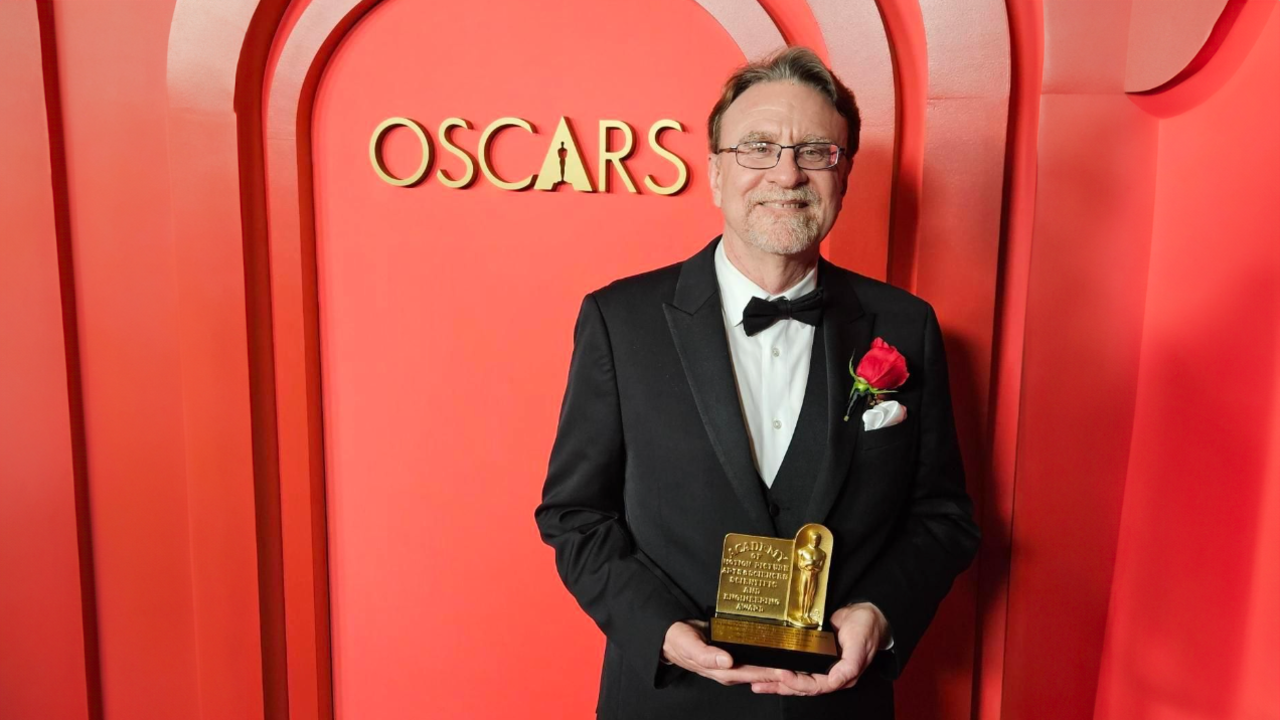
And the Oscar goes to…
Waterloo alum, Mike Perkins, wins an Academy Award for breakthrough tech that brings a new level of detail to the big screen

Waterloo alum, Mike Perkins, wins an Academy Award for breakthrough tech that brings a new level of detail to the big screen
By Val Maloney Faculty of EngineeringMost people don’t leave the cinema commenting on the picture’s colour contrast, saturation and brightness levels. Yet, the look of the movie can influence our enjoyment of it, and how well it does on the cinema circuit.
University of Waterloo alum Mike Perkins (BASc, '90), a principal product developer at local audio-visual solutions company Christie, led the development of a digital projector that takes movie-watching to a whole new level — illuminating the theatre screen with darker darks, brighter brights and colours not seen before in the cinema.
Built in collaboration with Dolby Laboratories, the Christie E3LH projection system presents audiences with imagery enhanced by high dynamic range (HDR) and a wide colour gamut (WCG). Perkins recently won an Academy Award in Scientific and Engineering for leading the team creating this innovative work.
"It’s been more than a little overwhelming,” Perkins says. “The Academy Awards is one of the best-known and highest respected awards in the world. They are given by a panel of experts who are truly passionate about cinema. To earn their respect is humbling. What I wasn’t prepared for is the incredible number of people who have heard about this and are genuinely proud for both Christie and me to be recognized. I am very grateful to everyone who has reached out to say congratulations.”
Using the (engineering) force
Perkins grew up loving math, science and computer courses and knew he wanted to have a career doing something technical. His dreams of wanting to make the “impossible possible” were first sparked at the movies, when he first saw Star Wars in theater at 11 years old.
That vision of using technical skills to make impossible things real led Perkins to study engineering at Waterloo, where, he recalls getting a “solid concept of what my life might look like.” After graduation, he moved to Montreal to work on satellites before returning to Kitchener-Waterloo where he worked in the projection systems division at Electrohome, that was acquired by Christie in 1999.
Christie is an AV manufacturer that produces a wide range of solutions for cinema and enterprise, including projection, LED and LCD, content management media servers and image processing for its customers. The company’s center for engineering excellence is in Kitchener, and it hires co-op students each term, with 19 working there this winter.
Reflecting on his time at Waterloo, Perkins recalls a key lesson from his instructors: to view design as an iterative process that reviews and improves each step before moving onto the next. This philosophy served him well in developing the now award-winning projector that enables the creation and playback of the E3LH Dolby Vision Cinema Projection System, which delivers new levels of colour and contrast, and was the first projection system to use High Dynamic Range (HDR) in movie theatres.
Perkins and his team began designing the E3LH system in 2012. The key parameter for the projector to achieve was contrast, specifically black levels which can be murky and mask details. “A typical cinema projector has a contrast ratio of 2,000:1 and we were developing one that needed to exceed 1,000,000:1, an improvement of 500 times. That essentially meant building a projector inside a projector,” Perkins shares. The process stumped him and the team until he had a breakthrough moment one day while driving.
"I had a lightbulb moment while driving and I just knew the path we should take," he says. "This [projector inside a projector] became the core concept that we worked on and evolved into the final product."
Bringing dreams to life
Cinema goers got their first taste of it in 2015 with the theatrical release of the movie Tomorrowland. Since then, the projector system has since been installed in over 300 Dolby Vision theatres across more than 15 countries to date.
Perkins remembers the immense satisfaction he felt when the Christie E3LH projection system was first installed in cinemas, especially when directors praised the projectors for revealing previously overlooked details in their movies.
"Directors were amazed at the number of little details they could see in their movies that they had forgotten about capturing and couldn’t see before, but were made visible by the projector," Perkins says. “People in Hollywood have adopted this technology, and it's standard pretty much in every movie that gets released now and has a Dolby version of it.”
With “winning an Academy Award” ticked on his bucket list, Perkins is working on bringing an enhanced cinema experience to the mainstream by decreasing the cost of the E3LH and its high-end home theatre sister projector Eclipse. “I want to find ways to get the costs down and take this level of performance to the mainstream.”

Read more
Here are the people and events behind some of this year’s most compelling Waterloo stories

Read more
Waterloo student develops an app to triage patient requests to enhance communication between hospital patients and their health-care providers

Read more
Meet five exceptional Waterloo graduate students crossing the convocation stage as Class of 2025 valedictorians
The University of Waterloo acknowledges that much of our work takes place on the traditional territory of the Neutral, Anishinaabeg, and Haudenosaunee peoples. Our main campus is situated on the Haldimand Tract, the land granted to the Six Nations that includes six miles on each side of the Grand River. Our active work toward reconciliation takes place across our campuses through research, learning, teaching, and community building, and is co-ordinated within the Office of Indigenous Relations.